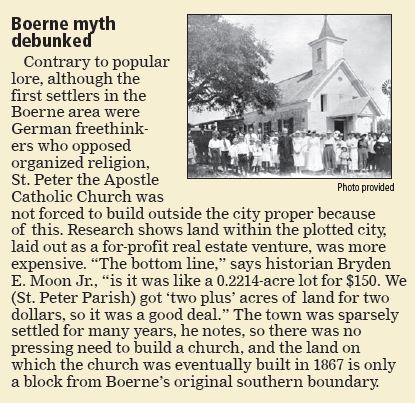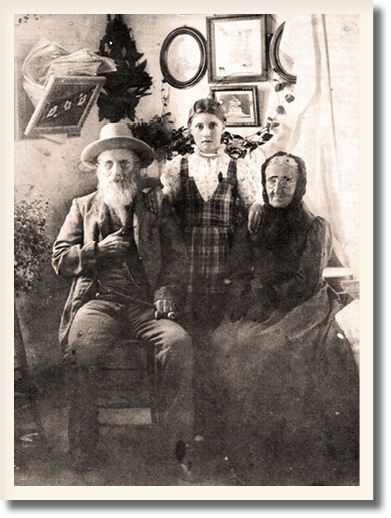BY CAROL BAASS SOWA
TODAY’S CATHOLIC
We are all immigrants or descendants of immigrants. Native Americans were immigrants in their own land, forced to assimilate to a new culture. While today’s immigrants are of different origins than in the past, they were drawn to America and Texas for the same reasons our forefathers came and similarly faced hardships and prejudices. Today’s Catholic will periodically examine how life was for some of the early immigrant ethnicities in our area, beginning with the Germans.
SAN ANTONIO • The largest group of non-English-speaking immigrants to the United States in the19th century came from Germany. Closer to home, Bryden E. Moon Jr., Boerne historian, notes that, prior to the 1910-1920 influx of immigrants from the Mexican Revolution, the largest ethnic group in “Hispanic SanAntonio” was German.
Until the late Republic of Texas era, he relates, “SanAntonio defined the outer edge of West Texas. There was nothing north of it. There was nothing west of it. ” Beyond San Antonio was Native American domain. It was into this setting that thousands of German/Prussian immigrants began arriving on Texas shores in the 1840s, seeking economic opportunities and a better life for themselves and their families. Increasing numbers, called the Forty-Eighters, came in the wake of the failed German revolutions of 1848-49 that crushed hopes for a united Germany with justice and freedom for all.
With eldest sons traditionally inheriting all family property, younger sons had no hope of owning their own land and only two career options — the clergy or the military. Many were reduced to eking out a serf-like existence on the property of others. Crop failures, conscription for wars, unemployment, industrialization and an entrenched system of feudal states with burdensome taxes and duties led to outcries against injustice and for personal freedoms by the beleaguered lower and middle classes and passionate university students.
“There were glowing reports on Texas,” says Moon, “overblown typically, about being the land of ‘milk and honey’,” and these caught many a disgruntled German eye. One German writer waxed poetically that in Texas “you could sow nails at night and have horseshoes in the morning!”
A group of German noblemen, for-profit and hoping to establish a “New Germany” in Texas, formed the Adelsverein or Society for the Protection of German Immigrants in Texas. Duped in their first land purchase as the seller did not have the rights to the land he sold, the Adelsverein then purchased land in the Fisher-Miller Grant. There was not time, to prepare this land for the first German immigrants who arrived in Texas in 1844, so two leagues were purchased at Comal Springs in 1845 by Prince Carl of Solms-Braunfels, who named the colony New Braunfels after his estate in Germany. Though intended as a waystation, a number chose to remain there, receiving an in-town plot and outlying land parcel.
A second Adelsverein colony, Fredericksburg, was established by John Meusebach in 1846 near the Pedernales River. A baron in Germany, he dropped his title and negotiated a treaty with the Comanche.
Some Germans who immigrated to Texas and learned their “Promised Land” was in Indian Territory opted to head off in other directions. Still, others remained on the coast. Wherever they settled, however, the Germans preferred to stay in groups and were of a clannish nature, continuing to use the German language and maintaining traditions of their fatherland, including clubs promoting singing, shooting and athletics, and competed in friendly competitions. They also supported reading and intellectual discussion groups and education for their children, including their daughters.
An Adelsverein group composed of idealistic, well-educated young men, hoped to create a socialistic Utopia in Texas. Members established the colony of Bettina on the Llano River that soon failed due to their lack of farming experience and unequal contributions of work. They dispersed but laid the foundation for a portion of the Hill Country’s concentration of freethinkers, who advocated reason and democracy over religious and political authoritarianism. A few started a Cibolo Creek farm, which some referred to as Tusculum, near what later became the city of Boerne.
In 1847, Nicolaus Zink, originally with the Adelsverein, was the first to settle in the wilderness that became Kendall County, followed by others, all purchasing land on their own. Later, speculators bought land as a real estate venture, laying out the town of Boerne, named in honor of Karl Ludwig Börne, a leading German political writer of his time who had converted to Lutheranism from the Jewish faith.
During the Civil War, many German settlers, including freethinkers, opposed slavery on principle and secession out of loyalty to the United States which had given them a new start, though others, in support of their non-German neighbors or fearing reprisals, sided with the Confederacy. Some were able to “do their duty” by serving as freight carriers for the Confederate Army or in the Frontier Battalion at home, which protected the settlers from Native American attacks after Union troops withdrew from Texas.
A number resisted Confederate conscription, fleeing to Mexico to start new lives or join the Union Army there. One large group was apprehended in what became the massacre at the Battle of the Nueces, in which German-American Unionists were brutally killed by Confederate forces. There is a monument to them in Comfort.
Wherever the German immigrants settled, frontier life was not easy. The daunting voyage from Europe took months and some died en route. Shysters preyed on them as they waited on the coast for transportation inland and guides sometimes abandoned settlers along the trail. One immigrant group, hiring a ship to take them from Galveston to Indian Point (near Indianola and Carlshafen), discovered the crew departing their stranded vessel in a rowboat in the dead of night and managed to steer the boat to port themselves.
The immigrants contended with dysentery from unboiled water and outbreaks of cholera and yellow fever. They saw their children die who might have lived had medical help been available. Their initial dwellings were small log cabins with thatched roofs, though many held shelves of books and other reminders of their old lives in Germany. In time, houses with stone walls and low fences of stacked rock were built.
Those in the Hill Country struggled through floods, droughts and marauding Native Americans. Those who had opted to make their home on Matagorda Bay later lost everything in the terrible hurricanes that destroyed Indianola.
Through it all, they persevered. The German language was commonly used in Hill Country communities until anti-German sentiment arose during World War I and World War II. Boerne historian Mary Taylor remembers her older cousins grew up speaking German, the only language used in her German grandfather’s home. Fellow historian Regina Adam recalls the FBI coming to Boerne during World War II to determine if there was any collusion with the Third Reich. There wasn’t, but afterwards, people quit speaking German, as a precaution. Moon discovered the Altar Society minutes at St. Joseph Parish, Honey Creek, abruptly changed from German to English during that period.
Today, the stigma of German ancestry is a long-past bump in the road, but there have been similar bumps in the difficult road of other immigrant nationalities, who have come to our country’s shores seeking the same opportunities for a better life as the Forty-Eighters.
Resources:
Historians Bryden E. Moon Jr., Mary Taylor and Regina Adam of the Dietert Historical Archives, Patrick Heath Public Library, Boerne; German Pioneers on the American Frontier: The Wagners in Texas and Illinois, by Andreas Reichstein; historian Theresa Gold and “The Hoelscher Family of Texas: History and Genealogy of Anton and Mary Katherine Hoelscher;” and the Texas State Historical Association Handbook of Texas, tshaonline.org.



